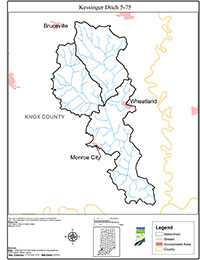Summary
Between July 24, 2001 and August 22, 2001, the Indiana Department of Environmental Management conducted a water quality survey of Kessinger Ditch, collecting samples at 16 sampling sites within the watershed. Of the 80 samples collected, 73 exceeded the water quality standard of 125 coliforms per 100ml as set forth in Indiana law (327 IAC 2-1-6), and 43 of the samples were higher than 600 coliforms per 100ml, or 5 times the standard. As a result of these high levels of E. coli, Kessinger Ditch was placed on the state’s 303(d) list of impaired waterways as required by the Clean Water Act. Having been designated as impaired, the watershed became eligible for planning grant funds through IDEM.
In the winter of 2003 the Knox County Soil and Water Conservation District (SWCD) realized that an opportunity existed to develop a watershed management plan (WMP) for the Kessinger Ditch Watershed. The SWCD applied for a 205(j) watershed planning grant in March of 2004 and the project was selected for funding.
The SWCD hired a watershed coordinator to manage the project and to ensure that the grant requirements were met. The watershed coordinator sought input from landowners, farmers, and residents in the watershed and an effort was made to establish an advisory committee to guide the effort. The watershed coordinator met individually with landowners, farmers, and residents of the watershed in an effort to ensure that a wide variety of stakeholder concerns and ideas were heard. “Working together to improve water quality in the Kessinger Ditch Watershed” was adopted as the mission statement for the project.
Water quality data were compiled during the project and combined with historical data from previous studies conducted by the IDEM and the U.S. Geological Survey. The data were analyzed and compared to public perceptions and concerns to determine which concerns were valid and in need of being addressed. A land use survey was conducted to identify stressors or potential stressors to be addressed during the implementation phase of the project.
Soil erosion, stream bank erosion, stream bank maintenance, livestock in streams, failed septic systems, and sediment laden runoff from coal mine surface operations were the initial concerns expressed by advisory group members. Watershed residents and farmers were interviewed and were found to have similar concerns, but they also expressed concern for fish and wildlife and frequently commented on the unattractive appearance of Kessinger Ditch. In general, farmers who have land adjoining the ditch were more concerned with keeping debris out of the ditch, keeping trees from growing on the ditch banks, controlling bank erosion, and reducing sediment buildup in the stream bed. Non-farming watershed residents were more concerned with the lack of riparian borders and corridors, wildlife habitat degradation, unattractive and murky water, and reduced fish populations.
The watershed coordinator worked with the county septic inspector to identify methods and funding sources for repairing failed septic systems in the watershed and to educate watershed residents on the importance of maintaining septic systems in good working order.
Farmers, landowners, watershed residents, SWCD supervisors and staff, and NRCS staff provided input for the development of the WMP by helping to identify water quality problems, suggesting ways to improve water quality, providing technical materials and assistance, and promoting the project to others.

